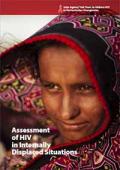Tools - Released in 2014
The factors that determine HIV transmission in internally displaced situations are complex and depend on the context. Internally displaced persons (IDPs) are defined as “persons or groups of persons who have been forced or obliged to flee or to leave their homes or places of habitual residence, in particular as a result of, or in order to avoid, the effects of armed conflict, situations of generalized violence, violations of human rights or natural or human-made disasters, and who have not crossed an internationally recognized state border”.
Following immediate response in emergencies, including minimal initial HIV and reproductive health interventions, more comprehensive HIV programming needs to be developed for IDPs. A broader framework for response is needed because the focus of intervention shifts from individuals to general social situations, processes, and displacement phases in which IDPs and their families live, which may continue for long periods of time.
Downloads
Organizations
- Inter-agency Task Team (IATT)






